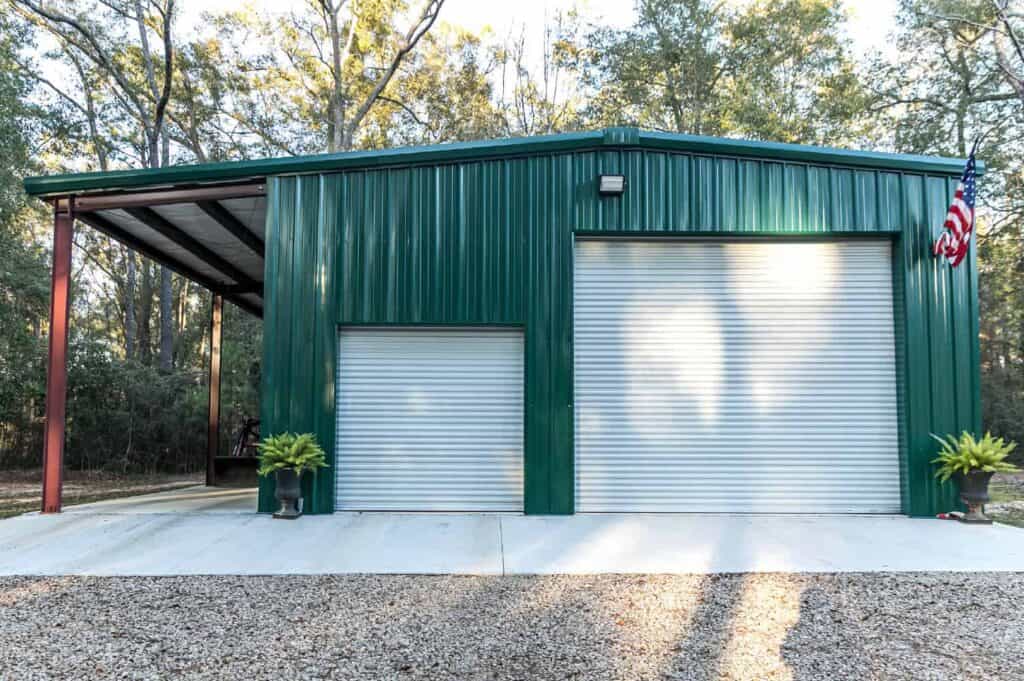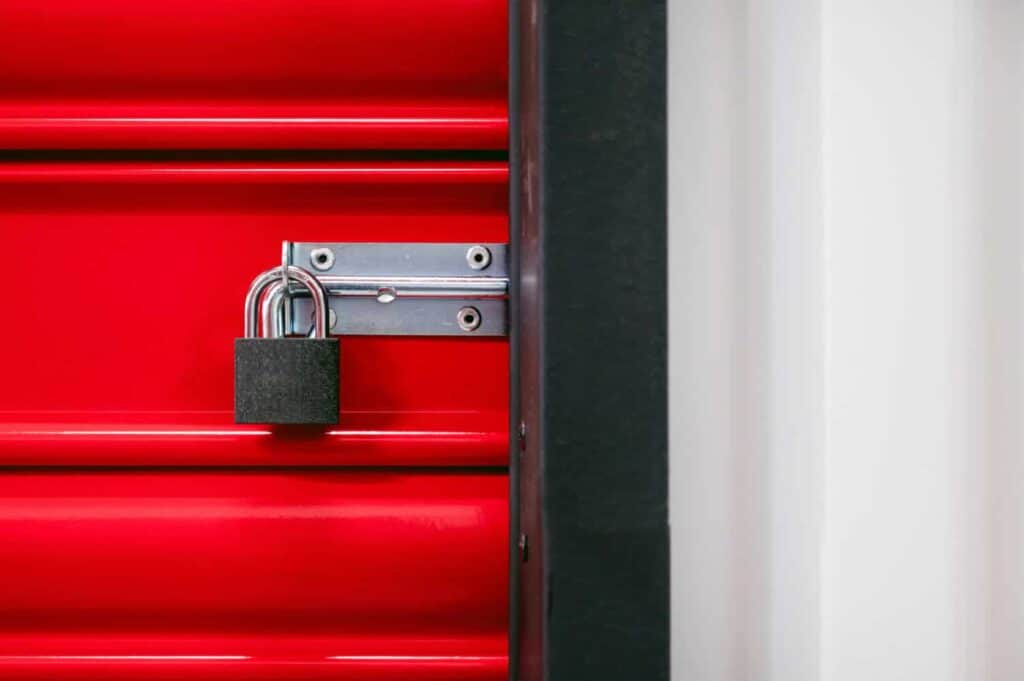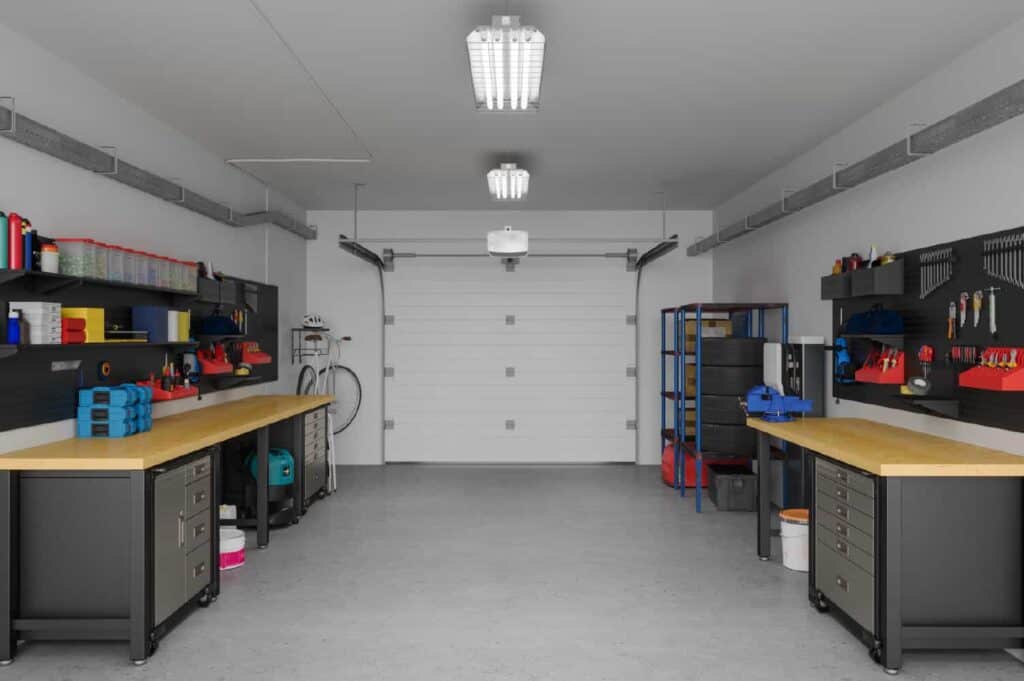Your garage houses your decades-old tool collection, vehicles, lawn toys, and more. So your garage security should be a priority, especially considering that nine percent of home burglars get in through the garage1.
It’s easy to assume it’s a safe storage space. But it’s vital to protect all of your property and valuables, which you can do using these 20 garage security tips and safe habits.
1. Identify Vulnerable Entry Points
First things first, identify your garage vulnerabilities. Walk around and think like a burglar. If you were locked out, how could you find a way in?
Typically, these are already known entry points that just need a little maintenance or upgrades. Here are some key areas to look into:
- Broken windows and locks
- Broken door thresholds and locks
- Weak, unreinforced pedestrian doors
- Pet doors
Once you know your garage’s weak spots, you can fix them to avoid attracting thieves looking for an easy in.

2. Lock the Garage Door
It seems like a no-brainer until you’re wrestling with kids or groceries while trying to unlock the house door.
Then, leaving the home-to-garage entry door unlocked seems so convenient—the rolling garage door is there, anyway. This might snowball into leaving the back garden door open since the kids are running in and out, and you have a privacy fence, anyway.
Once you start leaving these vulnerabilities open, opportunistic burglars will take notice. Secure all of your garage doors all of the time. Or else, that DeWalt drill might not be waiting for you next time you launch a weekend project.
3. Upgrade Your Garage Door Opener
Technology is always changing and you don’t need to upgrade everything in your house. But in the case of garage door openers, your outdated hardware might be a major garage security flaw.
New openers come in various styles, including chain and belt drive options, as well as smart features so you can always see if your door is open, closed, or locked.
We recommend getting a smart opener if you can. This provides several security improvements, including:
- Remote locks: Close and lock your door if you leave it open in a rush.
- Remote management: See the current status of your door to double-check you’re secure.
- Digital logs: See when your door was last opened or closed to catch suspicious activity.
- Remote alternatives: Remote openers are super convenient but far from secure. Anyone with access to your remote opener can access your home.
4. Get a New Garage Door
Your old garage door might be weak, warped, or poorly fitted, providing an opening to local thieves. If your door rattles with gaps around the perimeter, it’s probably time for an upgrade.
Avoid large windows that can be broken and entered through while browsing, and consider steel materials for extra strength. Steel is relatively affordable, ranging from $870–$1,940, while the average garage door costs $1,200.
Installation is particularly important. A new garage door should be securely installed to lock without gaps. If your garage door doesn’t fit, a thief might slip through existing gaps or use tools to reach interior locks.

5. Reinforce Door Frames
In addition to stronger doors and locks, consider reinforcing any existing door frames. A weak frame allows intruders to kick their way through the door by breaking apart the frame itself—your lock doesn’t do much for you in this situation.
You can replace the entire wood door frame with steel or simply install a sheet of steel over the vertical door jambs. This prevents the wood from splitting with force, making your door much harder to get through.
6. Install a Deadlock
Smart features are great, but it’s hard to beat the tried-and-true deadlock. These locks can’t be opened without a key, regardless of what side of the door you’re on. They’re the ultimate lock if you want to secure your garage.
There are other great, high-quality locks out there you can explore if you still want remote control. Here are the different lock types:
- Deadlock: Only opens with a key on each side of the door.
- Deadbolt: Installed with a doorknob set with a single locking interior bolt and key entry on the opposite side.
- Deadlatch: A deadlock that locks automatically when the door closes, though you can customize this setting.
Deadlocks are excellent for extra security. They’re harder to break into than your standard lock, but be careful about locking them while you’re inside if they lock the only entrance. You don’t want to get stuck inside during an emergency.
7. Install a Garage Door Padlock
If you don’t want to install a brand-new door lock, you can add a padlock for extra security. You’ll still need to install brackets to the door and frame so the padlock locks the door tight, but it’s a cheaper and easier project than replacing the entire lock.
You can also install a locking gate if you want to secure a carport or shed that a direct installation padlock might not work for.
Padlocks come in several sizes and strengths. Make sure you get one that can survive the elements outdoors. Also consider the size and exposure of the lock itself.
Ultra-long shackles are more vulnerable to bolt cutters than padlocks with short or guarded shackles. You can also buy a separate padlock guard to prevent tampering.

8. Put Valuables in Storage
If you’re really concerned about a nosy neighbor or suspicious activity, consider separating your most important valuables with locked storage. Keeping valuables out of sight is always a good idea, and the locks make them harder to access.
A fire-rated safe that bolts to the ground is one of the most secure options to protect against thieves and home disasters. Not only is it safe in your home, but the burglar can’t just take a bolted safe and run with the intent of breaking into it later.
That said, how much you invest in your security depends on what you’re storing. A locking cabinet or toolbox can also deter thieves—especially if they’re rushing to get in and out and there are easier items to grab.
9. Anchor Large Items
Breaking in is one thing—getting the goods out is another. Anchor any large, valuable items or locked cabinets to the ground or wall studs so they’re harder to take. You can also chain mobile items, like lawnmowers and motorcycles.
If your family loves to ride, consider locking bike storage. Bikes are popular items to steal because they’re easy to find and offload. In fact, 2 million bikes are stolen in the U.S. each year.2
10. Upgrade Home Security System
Home security technology is far from what it used to be. You have an arsenal of security tech available, from audio/video cameras you control with your phone to smart motion sensors that sound an alarm or flash a security light.
First, cameras are great for a few reasons:
- They’re a visible theft deterrent.
- They document suspicious and criminal activity.
- Smart cameras send mobile alerts, so you know something’s up sooner.
- Modern setups include two-way audio so you can interrupt a theft in progress.
This is an easy DIY investment, with many options available. You can choose a multi-cam system of high-definition, oscillating Bluetooth cameras or a budget-friendly, $50 indoor camera.
Of course, that’s not the end of your options. Outdoor sensor lights, smart locks, and door and window motion sensors are all relatively affordable and easy to install. A lot of modern systems can even connect to work together.
If DIY isn’t for you, you can always invest in professional security systems with remote monitoring and emergency service alerts. These are more expensive and often subscription-based, but they’ll definitely provide peace of mind.
11. Install Garage Lighting
Garage lighting is an excellent way to deter would-be burglars. Motion-activated lights are a sign that you’ve thought about your home’s security and taken measures to improve it already, which is a good sign there are other hurdles in the way.
If your house is harder to rob than the next, a thief is likely to move on to the next victim.
Sensor lights also make it easier for your neighbors to look out for you. If anyone sees the lights come on and suspicious movement in the dark, they can assess the situation and make the next move.
12. Cover Garage Windows
Part of securing your garage is removing temptation. Covering your windows is an easy and effective way to block thieves from seeing what you have to offer. If they can’t confirm your garage is full of treasures they want, they’re not likely to take the risk and break in.
Bonus: A new set of blinds, curtains, or window treatment can provide a little extra privacy while you’re working in the garage. You can also use it to block the sun and improve your garage’s insulation for mild temperature control.
13. Secure the Emergency Release Cord
Garage doors typically include a red emergency release cord for access if the power goes out. However, it’s an opportunity for nefarious folks wandering your neighborhood.
You still need access to the cord for emergencies, but you also want to prevent unwanted visitors from reaching through a garage door crack to trigger the release.
The solution is a simple tie-off so the cord isn’t visible, loose, and able to pull. Zip ties work well, but you can opt for other easy-to-cut materials. Keep scissors nearby so you can cut it quickly in an emergency, but anyone on the outside is out of luck.
14. Keep the Garage Tidy
This is good life advice anyway, but keep your garage well-organized. You’ll always know where your 10 mm wrench is, and burglars will have a harder time hiding once they’ve broken in.
The thief will also be running on a get-in, get-out timer if they don’t feel like they have alternatives to take their time.
Plus, you can invest in great garage storage to lock up your tools and hide valuables so they’re hard to find and steal.

15. Remove Spare Keys from Inside
Under doormats, behind the porch light, and tucked in a toolbox—these are all seemingly great, but painfully predictable, places to hide a spare key.
If you have spare keys on a garage hook or “hidden” under a barrel, it’s time to find a new hiding spot.
Key-code key safes are ideal. You can install the box on your wall, set a code, and place your spare keys inside. Everyone in the family can have access, but garage burglars won’t get access to your stored cars or home.
16. Lock Your Car
We’ve established that your car isn’t safe just because it’s in a locked garage, so don’t leave it unlocked. If someone gets into the garage, it’s easy to throw your car in neutral and roll it out, hot wire it, or use that spare key you never moved.
It also allows the thief to access any valuables you might store in your car. Other keys, personal documents, or cash are all up for grabs, then.
17. Join a Neighborhood Watch Group
A supportive and communicative community is a burglar’s worst bet. Get to know your neighbors, exchange phone numbers for emergencies, and maintain a good relationship.
You can all look out for each other and report suspicious activity. This will be extremely helpful if you have to leave home for a vacation or work, and you should absolutely return the favor.
Once a relationship is established, you might find many other perks of integrating yourself into a community. It’s easier to set up playdates, you can help each other maintain lawns and clear sidewalks, and you’ll enjoy merrier backyard BBQs with more grillmasters on the block.
18. Report Suspicious Activity
If you see something, say something. There are many ways to connect with emergency services and your neighbors to help keep everyone safe.
If someone suspicious comes knocking on your door, trying to sell satellite services, and peeking into your home, it’s a good idea to report that to your neighborhood.
Contact any neighbors you can directly, as well as an HOA if you have one. You can also use social media like Facebook groups and the Nextdoor app to get the word out.
More serious activity, like an unknown stranger stalking backyards at night, should go to the police immediately. File a report so they can investigate and maintain a paper trail if something turns up later.
19. Change Passwords Periodically
If you’ve already invested in smart security tech, keycode door knobs, and other passcode technologies—fantastic! But the job’s not over. You have to regularly change your passwords to keep the garage secure.
Breaches happen—both at massive scales, like Facebook security leaks, and personal instances, like family friends sharing information.
There are a few ways to protect yourself:
- Don’t reuse passwords—ever.
- Use a mix of uppercase and lowercase letters, numbers, and symbols (!,$,*) so your password is hacker-proof.
- Aim for 8+ characters—12+ if you want super security.
- Update your passwords and codes every six months or so.
- Change your passwords if you’re part of a data breach.
20. Perform Regular Maintenance
Once your garage is secure and you’ve closed any gaps and weak entry points, it’s time to maintain it. Garage doors and windows will wear over time.
The installation hardware might shift and create gaps, or doors and springs might weaken with rust. Proper garage maintenance will prevent damage like rust, but sometimes it’s inevitable. Replace damage as soon as you catch it before it worsens or becomes a thief’s shining opportunity.
Customize a Burglar-Proof Metal Garage
Some garage security habits are natural, like locking your garage door, while others require more practice, like putting your valuables away in a locked cabinet.
Your personal habits and garage features, like security lights and locks, all help keep your property protected. If your garage is old and needs extensive repairs, consider a custom-built garage with security built-in from the beginning.
Our pick? Metal garages are ultra-durable, they won’t rot like wood, and they’re fireproof, so you can rest easy about theft and home disasters.
Sources:
- “How Do Burglars Break into Houses” ADT, n.d. https://www.adt.com/resources/how-do-burglars-break-into-houses.
- Clarke, John. “Your Bike Just Got Stolen. These Vigilantes Will Get It Back” The Wall Street Journal, February 29, 2024. https://www.wsj.com/us-news/your-bike-just-got-stolen-these-vigilantes-will-get-it-back-af45a9d0.




